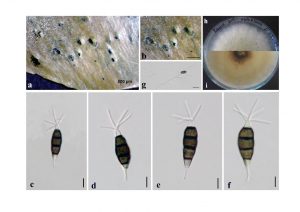Pestalotiopsis verruculosa Maharachch. & K.D. Hyde, in Maharachchikumbura, Guo, Cai, Chukeatirote, Wu, Sun, Crous, Bhat, McKenzie, Bahkali & Hyde, Fungal Diversity 56(1): 123 (2012)
Index Fungorum number: IF 800527; MycoBank numbers: MB 800527; Facesoffungi number: FoF 06983
Saprobic on dead cone of Picea excelsa appearing as rounded to elongated, slightly raised black lesions errupting through irregular slits on host surface tissue. Asexual morph: Conidiomata semi-immersed to erumpent or partially erumpent, exuding brown to black conidial masses, acervulus, mostly oval to elognate, 175–250 μm in diam., solitary, black. Conidiomata wall indistinct, composed of light brown cells fusing with host tissue. Conidiophores not observed. Conidiogenous cells holoblastic, discrete or integrated, hyaline, smooth-walled, cylindrical to lageniform. Conidia broad fusiform, mostly straight, verruculose, occasionally slightly curved, 4-septate, slightly constricted at septa, 25.5–32 × 8.7–9.5 μm, (x̅ = 30.5 × 9.2 μm, n = 40), basal cell obconic with a truncate base, colourless, smooth-walled, 4.5–5.5 μm long; three median cells 16–20 μm long, subcylindrical or doliiform, concolourous, brown to dark brown, second cell from base sometimes lighter, septa darker than the rest of the cell (second cell from base 6–8 μm long; third cell 6–8 μm long; third cell 6–8 μm); apical cell conic, hyaline, thin-walled, smooth, 3.6–4.5 μm long; with 4 or occasionally 3, tubular, unbranched, flexuous, apical appendages arising from the apical tip, 10–25.5 μm long, not knobbed; basal appendage single, unbranched, filiform, centric, up to 5.5–9.5 μm long. Sexual morph: undetermined.
Culture characteristics — Colonies on PDA reaching approximately 7 cm in diam. after 7 days at 16–18 °C, greyish-white, round colony, with entire margins and reverse dark brown at the center becoming pale yellow towards the margins.
Material examined – Italy, Forlì-Cesena Province, Camposonaldo – Santa Sofia, on dead cone of Picea excelsa, 6 May 2012, Erio Camporesi, IT 309 (MFLU 15-0777), living culture MFLUCC 14-0810.
GenBank submissions – ITS: MN733174.
Known distribution (based on molecular data) – China (Maharachchikumbura et al. 2012), Italy (this study).
Known hosts (based on molecular data) – Picea excelsa (this study), Rhododendron sp. (Maharachchikumbura et al. 2012).
Notes – Pestalotiopsis verruculosa was introduced as an endophyte by Maharachchikumbura et al. (2012) from living leaves of Rhododendron species. It was distinguished from other related taxa in having larger conidia (28–35 × 9–11 μm) and 3–4, but longer apical appendages (25–40 μm). Our strain had similar conidial dimensions (25.5–32 × 8.7–9.5 μm), but shorter appendages (10–25.5 μm). Pestalotiopsis verruculosa also shares similar morphological characters with P. hollandica in having 25.5–33 × 8.5–10 μm (Maharachchikumbura et al. 2014) sized conidia bearing 1–4 appendages. In their recent study of Sporocadaceae and phylogenetic analysis of Pestalotiopsis, Liu et al. (2019) suggested the species P. brassicae, P. hollandica, P. italiana, P. monochaeta, P. sequoiae and P. verruculosa may be synonymous, however, additional genes are necessary to resolve this. Our phylogenetic analysis presents results similar to Liu et al. (2019). Based on the morphological comparisons and that our isolate grouped with the type strain of P. verruculosa (MFLUCC 12-0274), we identified our strain as P. verruculosa.

Fig. Pestalotiopsis verruculosa (MFLU 15-0777, a new host and geographical record). a, b Appearance of conidiomata on the host. c–f Conidia. g Germinating spore. h, i Culture on PDA (h: from the above, i: reverse view). Scale bars: a, b = 500 µm, c–f = 20 µm, g = 50 µm.
